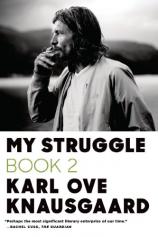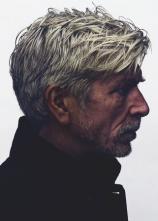Reading Group Guide
Discussion Questions
My Struggle: Book 2

1. Book 2 starts with an extended description of the chaos that has become of Karl Ove’s life, now that he has three children of his own. It is quite a break from the end of Book 1, where he was childless, uncertain of his romantic relationships and mourning the death of his father. Why do you think Knausgaard chose to juxtapose these two versions of himself at the end of Book 1 and the start of Book 2? What does this opening say about what you can expect from Book 2, and how it will differ from Book 1? What do you think this says about the impact of family on one’s life story?
2. Early on in Book 2, while at a birthday party, Karl Ove recalls how he was once upstaged by a boxer when it had been necessary to break down a bathroom door: He, Karl Ove, failed to do it, but the boxer swiftly broke it in. Karl Ove recalls this because he’s trying to explain his feelings of emasculation. Why do you think having a masculine image is so important to him? Do you find these sorts of ideas about men old-fashioned and silly, or do you think his concerns are valid?
3. The opening of Book 2 is dominated by domesticity: a child’s birthday party, Karl Ove’s interaction with his children and his home life as a married father. What aspects of family life does Knausgaard choose to highlight? What does this say about his ideas of fatherhood and family? How are these informed by his own experiences with his father?
4. Things begin to shift away from Karl Ove’s family life when he picks up a volume of Dostoevsky and begins to read it in a café --- in fact, he gets so wrapped up in the book that he completely forgets his family obligations and nearly misses an appointment. Do you think the literary realm and the family realm are in conflict for Knausgaard? What might books offer to him that he’s not getting from his family?
5. While reading Dostoevsky, Knausgaard muses that “whereas before man wandered through the world, now it is the world that wanders through man. And when meaning shifts, meaninglessness follows.” He’s talking about how ideas of personal psychology and inner life have come to dominate our understanding of ourselves in the twentieth and 21st centuries. What roles do books play in this understanding? Why might Knausgaard, as an author, be particularly attuned to the benefits and perils of a life lived through words?
6. Throughout Book 2, Knausgaard returns again and again to the story of one of his neighbors, a lonely alcoholic Russian woman who was abandoned by her husband. She terrorizes Karl Ove and his family by blaring her music at all hours and being a menacing presence in his apartment building. Why might Knausgaard have wanted to include her in this book about passion and family? How does he interact with her, or fail to? How does she act as a foil to Karl Ove’s own family life?
7. Karl Ove talks about reading a copy of his friend Geir’s book, THE AESTHETICS OF A BROKEN NOSE, which he describes as being about “anti-liberal” cultures. He links this book to books of other thinkers, like Michel Serres and Michel Foucault, who tried to offer reference points from outside of Western civilization so that we might evaluate our culture and think about its implicit assumptions and ideas. How is Knausgaard trying to do this in MY STRUGGLE? How might this be linked to his uneasiness around masculinity? Why is it important to think about such things and question society in this manner?
8. In Book 2, Knausgaard delves into his early days as a writer, which coincided with an extremely wild portion of his life. In particular, he drank too much and was prone to blackouts and bad deeds, which may have included sleeping with a 13-year-old girl. This period in Karl Ove’s life is highly associated with Geir and the development of their friendship as adults. How is Geir the ideal person for Karl Ove to be with at this point in his life? And how does their relationship change once Karl Ove settles down and attempts to become a family man? What role does Geir serve in Karl Ove’s life?
9. In telling the story of his past, Knausgaard recalls how, while at a writers’ retreat, he begins to become seduced by Linda (whom, years later, he will marry and start a family with), even though he is at that time married to a woman named Tonje. In trying to comprehend these feelings, Knausgaard writes that he remembers “thinking that I was in the middle of my life. Not life as an age, not halfway along life’s path, but in the middle of my existence.” What is the difference Knausgaard is drawing here between an “age” or “life’s path” and “existence”? How does “existence” feel more fundamental and more high-stakes than the other two? Reading this, why do you think he decides to leave Tonje and try his luck again as a single man? How do such questions return to the roots of why Knausgaard wanted to write MY STRUGGLE?
10. In describing the passionate romance that Karl Ove falls into with Linda, Knausgaard writes about how he feared losing his independence and his writer’s lifestyle, even as he wanted to be in love with her. What is the trade-off between family and freedom? How are Karl Ove’s fears seen throughout the rest of Book 2? In particular, you might think about his long conversations with Geir, his descriptions of reading and writing alone, and his descriptions of family life as a married man with children.
11. Karl Ove’s friend Anders has an interesting relationship to money: He has a huge capacity to earn it, but he goes through it just as fast, buying expensive items and gambling it away. His line of business is unclear, but Knausgaard says it’s illegal to an extent. Anders doesn’t really understand Karl Ove’s values and doesn’t even pretend to be interested in art, and Karl Ove respects this attitude. Why do you think Karl Ove maintains a friendship with Anders? And given that Anders makes lots of money as a scammer, and Karl Ove makes very little as a literary writer, what does this say about the sorts of things that their society values and rewards monetarily? What do you think motivates Karl Ove and Anders? Can you see any commonalities between them?
12. The birth of Karl Ove’s first child, Vanja, is a major moment in the novel. He and his wife Linda exchange words during the birth that are unlike any others in Book 2. Afterward, Karl Ove continues trying to work on his second book while being a father, much as before the birth, although things are unmistakably different. How is Karl Ove’s life different after the birth of Vanja? What new tensions does it introduce into his relationship with Linda? What new things does it make him think about?
13. Musing on his life as a father, Knausgaard says that “children were life.” By contrast, he says of writing “what else was it but death? Letters, what else were they but bones in a cemetery?” Why might a writer, especially one who is writing his entire life story, call writing “bones in a cemetery”? It is often said that writing a classic novel gives you a sort of immortality, because your words will continue to live on even after you die. From that perspective, might writing be life, too? How does this differ from having a child, which also allows you to live on past your own death in a way? What do you think Knausgaard would say about immortality gained through writing?
14. Knausgaard says that when you reach 40 years of age, you realize that “it was all here, banal everyday life, fully formed, and it always would be unless you did something. Unless you took one last gamble.” Do you ever feel trapped by the everyday like this? In what ways might MY STRUGGLE have been just this sort of gamble for Knausgaard? What might this realization that at forty one becomes saturated with banal everyday life have to do with the many, many descriptions of banal, everyday details that Knausgaard places throughout these books?
15. During Vanja’s christening, Karl Ove unexpectedly takes communion. After the incident, which he is at a loss to explain, he wonders why he did it and if that act has now made him a Christian. He goes on to reflect on the fact that the priest had been hesitant to christen his daughter because he and Linda were not married, and, moreover, because he didn’t believe in Christian religious doctrine. What does this moment say about the importance of tradition and ritual in our lives? Do you think taking communion makes Karl Ove a Christian? Do you feel that ideas of sacredness and spirituality have a place in these books, even if Knausgaard isn’t formally religious?
16. Karl Ove’s friend Geir calls him an “auditor of happiness,” which he describes like this: “If you have some success, generally something others would have died for, you just cross it off in the ledger. You’re not happy about anything.” Do you think this is a normal or abnormal way to react to success? Do you feel that this partly explains why Knausgaard is so driven to succeed? Is this a good attitude or a bad attitude for a writer/artist to have?
17. During a long conversation at a bar with Geir, Karl Ove says that when he moved to Stockholm and fell in love with Linda, he finally felt like he had been raised above the trivial matters of life. To go beyond the minutiae is something Knausgaard desires very passionately; this could be thought of as the struggle behind MY STRUGGLE Why do you think Knausgaard struggles so hard to rise above banality? Is a passionate love the only way one can attain such a feeling? Can anyone stay above the minutiae of life forever?
18. Think about the major plot points of Books 1 and 2: Karl Ove’s adolescence, the death of his father, Karl Ove’s marriage, and the birth of his children. How are these events linked to different stages of life? Is it inevitable that in telling your life story, you will order it around these sorts of events? Do you feel that Karl Ove’s life “breaks the mold” in certain ways?
19. After reading two books about Knausgaard, what do you think of him as a person? What adjectives would you use to describe him? Do you think he’s a good father? What motivates his writing?
My Struggle: Book 2
- Publication Date: June 3, 2014
- Genres: Literary, Nonfiction
- Paperback: 608 pages
- Publisher: Farrar, Straus and Giroux
- ISBN-10: 0374534152
- ISBN-13: 9780374534158







